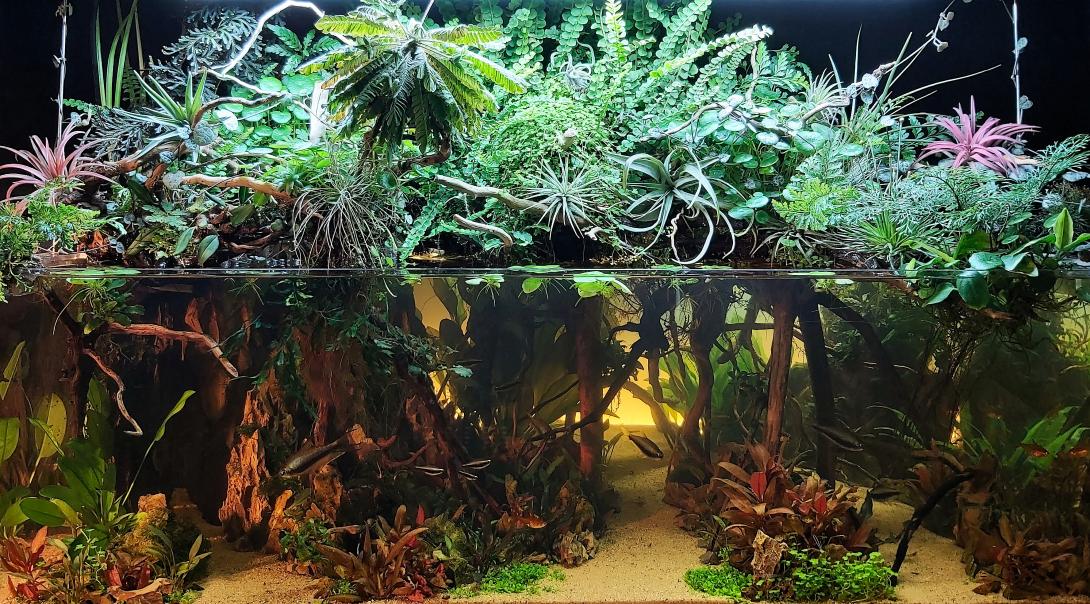
Melissa
Schöllkopf
Hardscape
Substrate
Plants
Animals
Filter
AquaClear30 Hang On Filter, Evilandat AP-300 Corner filter, Eheim miniFlat for irrigation
Lightpower
Main lamp: 9600lm + 2 single lamps each 650lm
Lightduration
9.00 hours
CO2
none
Fertilizer
pH
6.20
KH + GH
1+3
Maintenance routine
Daily addition of fertilizer.
Weekly waterchanges with 20l of blackwater (peat filterd) and 5l of clear rainwater.
Weekly cleaning the pump an the tubes for irrigation, as well as the fogger.
Trimming the plants every second week.
Once in a month cleaning hang-on filter and corner filter.
Weekly waterchanges with 20l of blackwater (peat filterd) and 5l of clear rainwater.
Weekly cleaning the pump an the tubes for irrigation, as well as the fogger.
Trimming the plants every second week.
Once in a month cleaning hang-on filter and corner filter.
Description
On the edges of the Amazonia river and its branches lie the floodplain forests. These areas are flooded for several months of the year during the rainy season. From the rising levels of the rivers up to the treetops, the vegetation below sinks completely in the often tea-colored floods, for example in the Rio Negro. In line with this Amazonian area, the paludarium was designed as a black water basin with an almost closed plant cover above the water surface and was set up in November 2020. Due to the rapid growth of the plants in the land area, the Chihiros A601+ was soon no longer sufficient to provide enough light for the plants underneath in the blackwater. At the moment, two Aquael Leddy Smarts as well as a back wall lighting and a spot on the left side of the cave additionally illuminate the scenery. Since it was almost impossible to take a photo with the usual water composition in which the plants and contours are clearly seen (see additional file), the peat filterd black water content was slightly reduced in the last picture and temporarily replaced by a higher proportion of clear rainwater.
Five Otocinclus affinis, seven Hyphessobrycon amandae, seven full-grown Nematobrycon palmeri, together with six youngfish from their breed, are currently living in the paludarium. The Nematobrycon palmeri seem to feel comfortable in the black water basin, in total they have given birth to over a hundred young fish in the last year, of which all of them were given into good hands after nurturing them in a separate basin. The constant reproduction of the Caridina pareparensis parvidentata now reduces the number of young fish a little, but I am always happy to see more offspring from time to time.
As mentioned, the idea behind the paludarium is to represent a floodplain in a South American rainforest when the water from the rivers rises during the rainy season.
To achieve this effect, I glued the moorwood to slate and placed it upright in the basin. An almost 40cm high dragon stone and countless smaller stones complete the picture. I planted the resulting overwater landscape with various terrestrial and aquatic plants, some glued, tied or just put it in the forks of branches. The stone was also planted accordingly. The land part is watered through several hoses, and an additional fogger keeps the plants wet.
For the design of the underwater part, I created three paths in the aquarium, a main path that leads backwards directly under the treetops, straight to the sunset, which is generated by the back wall lighting, and two side paths, one on the left that leads behind the stone into the cave, and one path on the right which leads past a smaller dragon stone (approx. 26cm) in a wide arch and then joins the main path again. The background and the left side are planted with different species Echinodorus and Microsorum pteropus petit, the roadsides are lined with different Cryptocoryne, Alternanthera reineckii mini and Micranthemum tweediei sp.Monte Carlo, as well as some areas with Hydrocotyle tripartita mini and occasionally Hydrocotyle verticillata, which are both also be found in the upper area above the water surface.
To create a connection between land and water, I planted the stones with Riccardia sp. chamedryfolia, and set various Bucephalandra and Anubias barteri var nana bonsei on some branches under the surface of the water.
The roots of the plants above the water, which are hanging down, swing like lianas in the current, further helping the two different parts to become a complete picture.
Five Otocinclus affinis, seven Hyphessobrycon amandae, seven full-grown Nematobrycon palmeri, together with six youngfish from their breed, are currently living in the paludarium. The Nematobrycon palmeri seem to feel comfortable in the black water basin, in total they have given birth to over a hundred young fish in the last year, of which all of them were given into good hands after nurturing them in a separate basin. The constant reproduction of the Caridina pareparensis parvidentata now reduces the number of young fish a little, but I am always happy to see more offspring from time to time.
As mentioned, the idea behind the paludarium is to represent a floodplain in a South American rainforest when the water from the rivers rises during the rainy season.
To achieve this effect, I glued the moorwood to slate and placed it upright in the basin. An almost 40cm high dragon stone and countless smaller stones complete the picture. I planted the resulting overwater landscape with various terrestrial and aquatic plants, some glued, tied or just put it in the forks of branches. The stone was also planted accordingly. The land part is watered through several hoses, and an additional fogger keeps the plants wet.
For the design of the underwater part, I created three paths in the aquarium, a main path that leads backwards directly under the treetops, straight to the sunset, which is generated by the back wall lighting, and two side paths, one on the left that leads behind the stone into the cave, and one path on the right which leads past a smaller dragon stone (approx. 26cm) in a wide arch and then joins the main path again. The background and the left side are planted with different species Echinodorus and Microsorum pteropus petit, the roadsides are lined with different Cryptocoryne, Alternanthera reineckii mini and Micranthemum tweediei sp.Monte Carlo, as well as some areas with Hydrocotyle tripartita mini and occasionally Hydrocotyle verticillata, which are both also be found in the upper area above the water surface.
To create a connection between land and water, I planted the stones with Riccardia sp. chamedryfolia, and set various Bucephalandra and Anubias barteri var nana bonsei on some branches under the surface of the water.
The roots of the plants above the water, which are hanging down, swing like lianas in the current, further helping the two different parts to become a complete picture.
